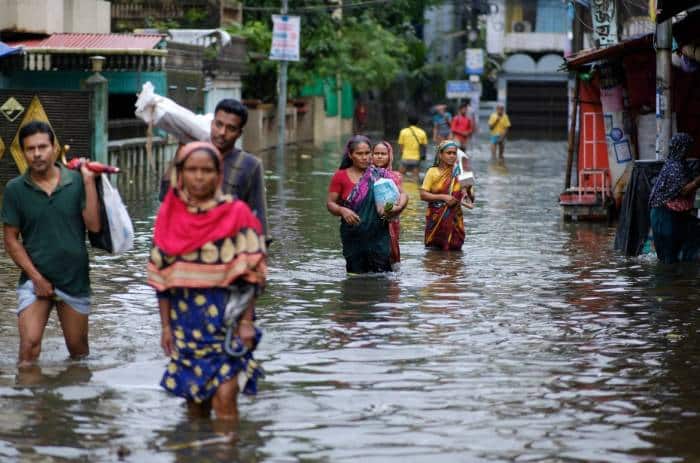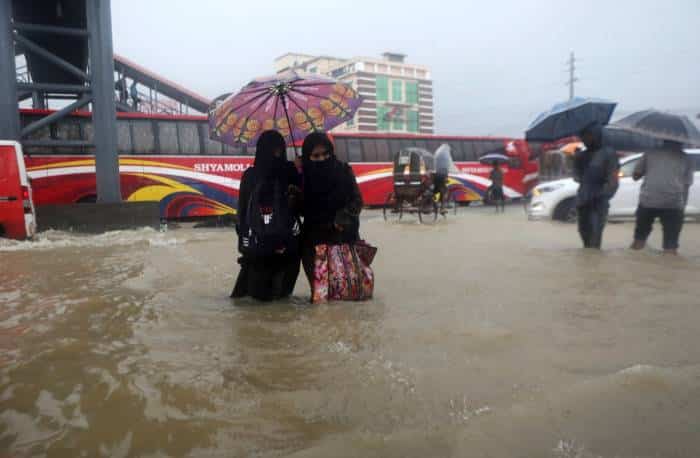
The latest floods have devastated Bangladesh. [Mahmud Hossain Opu/AP Photo]
“নদীর ধারে বাস, দুঃখ বারোমাস” translated as “Living by the river, suffering twelve months in a year.” This is the story of people living in Bangladesh and Northeast India. These areas are flooded every year, so it may look like a common natural phenomenon we cannot control. Residents have to endure floods every year. They lose lands, properties, and whatever resources left of them yearly. They face river erosion, food insecurity, and an uncertain future even when no flood exists.
Due to heavy rainfall in the state of Assam and Arunachal in India, the water of the Surma and Kushiyara rivers started to overflow. It caused flooding in the Northeast states of India and the northern region of Bangladesh. The first phase of heavy rains and mountain slopes began in May 2022. It caused heavy floods in the Sylhet district. The subsequent flow of heavy rains and mountain slopes worsen the flood situation. This time, the Surma, Sari, the Luva, the Dhalai, and the Kushiyara river also overflowed. So the waters spread to Sunamgong, Gaibanda, and currently, 72% of Sylhet Division is underwater.
It is the worst flood in 122 years and has already affected 7.2 million people. Many more districts are at risk of floods. Several areas experienced long hours of power outages due to water in the grid station, so people couldn’t use their electronic devices, which caused the evacuation of flood-affected people more difficult. Many roads and the railroad were underwater leaving the affected areas isolated from the rest of the country. Sylhet’s Osami International Airport has shut down due to the flooded runway.
View this post on Instagram
The cause of the flood may seem due to heavy rainfall, but the climate crisis indeed made it worse. Even before the onset of the monsoon season, heavy rains lashed parts of Bangladesh and India, even as the IPCC report highlighted the monsoon shift in South Asia. The precipitation’s intensity and the weather’s unpredictability make it hard for the rural people to take necessary precautions. Bangladesh has one of the best adaptation policies and disaster response in times of flooding. Still, with the intensity and unpredictability of floods, the policy is not working to minimise loss and damages. People in Sylhet and Sunamgonj didn’t have enough time to move to the shelter centres with their valuable belongings. The flood water increased so fast that they had to leave their domestic animals and valuables behind in their flooded home.
Flood in Sylhet, #Bangladesh have caused extreme damage to people as well as animals, birds and nature. 😭
We’re Drowning & World leaders are watching.😭#SaveSylhet #prayforsylhet #SaveBangladesh #ClimateEmergency #ClimateCrisis #PeopleNotProfit #ActOnClimate #ClimateJustice pic.twitter.com/6wV2xEcGNa
— Husain Ahmed Emran (@husainAemran) July 3, 2022
People try to survive as monsoon rains swamped huge areas of the country, leaving millions of homes underwater in Sylhet, Bangladesh. At least 13 people died and many were left stranded due to floods devastating the country pic.twitter.com/bGGnlJvMfZ
— zakir hossain chowdhury (@auni_auniket) June 18, 2022
Even though river navigability is the leading cause of the flood, the unplanned construction of dams in the lakes, arbitrary road constructions, occupying the river lands, ‘haor(Sylhet’s traditional wetlands)’ destruction are some other causes of the flood. The system continues to fail us. The local authority was unable to monitor and stop these destructive projects.

According to the United Nations’ Intergovernmental Panel on Climate Change (IPCC), about 17 percent of people in Bangladesh would need to be relocated over the next decade or so if global warming persists at the present rate. [Abdul Goni/AP Photo]
Bangladesh and India face floods every year, aggravating the suffering of more and more people. The causes are evident. The climate crisis is one of the biggest reasons for our suffering. While the floods devastated Bangladesh, the 56th subsidiary bodies meeting in Bonn, Germany, couldn’t include loss and damage in the agenda of the upcoming COP27. We don’t need aid but reparation for all losses and damages we face. We need adaptation funds with a proper roadmap to see the money pipeline. We need to push for a ‘Green New Deal’ with appropriate guidelines for phasing out all fossil fuels from our Energy Master Plan (coal, oil, and gas).